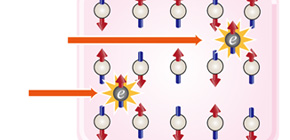
Successful exponential increase in NMR signals at room temperature
Costs will be cut significantly
A group of researchers led by KITAGAWA Masahiro (Professor, Division of Advanced Electronics and Optical Science, Systems Innovation, Graduate School of Engineering Science, Osaka University) have succeeded in exponentially increasing the intensity of nuclear magnetic resonance (NMR) signals at room temperature by means of the Dynamic Nuclear Polarization (DNP) method using electronic spin in photo-excited triplet states (triplet-DNP).
Triplet-DNP aligns the direction of nuclear spin with an irradiating laser beam and microwaves regardless of temperature. The sensitivity of NMR spectroscopy and MRI is proportionate to polarization. Spin polarization is usually very low, less than one-tenth of thousandth at a room temperature. This group has succeeded in achieving H spin polarization of 34 percent, a world first. A nuclear spin of 34 percent polarization emits signals 10,000 times that of normal NMR spectroscopy or MRI. This method is expected to make it possible to increase the sensitivity of normal NMR by about 10,000 times and make it possible to analyze samples of minute amounts, one-tenth of a thousandth.
This method does not need ultra-low temperatures which conventional hyperpolarizaiton methods needed. So it is expected to drastically increase the sensitivity of NMR spectroscopy and MRI. If it is put to practical use, cost will be cut significantly. The method will contribute to material science and biochemistry, especially in microanalysis of materials and living substances, both of which are damaged at extremely low temperatures.
There is also a possibility of application to medical care. For example, identifying tumor locations by injecting hyperpolarized substances into the body and imaging their metabolism by MRI. Hyperpolarizated nuclear spin many-body systems in crystal can be used in a quantum simulation of magnetic phase transition. Therefore, samples with hyperpolarized spin state in bulk at room temperature can be used in quantum simulation of target substances in scattering experiment and magnetic phase transition. In this way, this group's achievement will make a contribution to a wide range of fields including basic physics, chemistry, material science, biological science, and medicine.
Abstract
Dynamic nuclear polarization (DNP), a means of transferring spin polarization from electrons to nuclei, can enhance the nuclear spin polarization (hence the NMR sensitivity) in bulk materials at most 660 times for 1 H spins, using electron spins in thermal equilibrium as polarizing agents. By using electron spins in photo-excited triplet states instead, DNP can overcome the above limit. We demonstrate a 1 H spin polarization of 34%, which gives an enhancement factor of 250,000 in 0.40 T, while maintaining a bulk sample (∼0.6 mg, ∼0.7 × 0.7 × 1 mm 3 ) containing >10 19 1 H spins at room temperature. Room temperature hyperpolarization achieved with DNP using photo-excited triplet electrons has potentials to be applied to a wide range of fields, including NMR spectroscopy and MRI as well as fundamental physics.

Figure 1

Figure 2
To learn more about this research, please read the full research report entitled "Room temperature hyperpolarization of nuclear spins in bulk" at this page of the Proceedings of the National Academy of Sciences website.
Related link :
